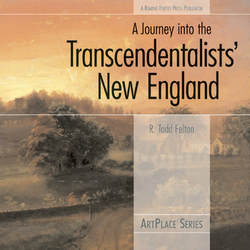Читать книгу A Journey Into the Transcendentalists' New England - R. Todd Felton - Страница 13
На сайте Литреса книга снята с продажи.
Transcendentalism—Whatever Is Unintelligible
ОглавлениеChristopher Cranch’s caricature of the “transparent eyeball” pokes good-natured fun at Emerson’s occasionally overblown figurative language.
Transcendentalism is a loose affiliation of highly abstract, often vague, occasionally contradictory ideas. It is therefore not surprising that there are as many definitions of Transcendentalism as there are critics to write them. Many of these are intelligent and insightful attempts at defining the movement; some, however, border on nonsense.
For example, one of Emerson’s favorite ministers, Father Edward Thompson Taylor of the Seaman’s Bethel in Boston’s North End, dubbed Transcendentalism a “seagull with long wings, lean body, poor feathers, and miserable meat.” Rebecca Harding Davis, a young contemporary of the Transcendentalists, offered this account of how the eager philosophers of the movement were initiated: “The new dialect of the Transcendentalist was easily learned. They talked it as correctly as the Chinaman does his pigeon [sic] English. Up to the [Emerson’s] old gray house among the pines in Concord they went—hordes of wild-eyed Harvard undergraduates and lean, underpaid working-women, each with a disease of the soul to be cured by the new Healer.”
One of the least helpful but most humorous definitions was rendered in the wry wit of Victorian novelist Charles Dickens:
The fruits of the earth have their growth in corruption. Out of the rottenness of these things, there has sprung up in Boston a sect of philosophers known as Transcendentalists. On inquiring what this appellation might be supposed to signify, I was given to understand that whatever was unintelligible would be certainly transcendental. Not deriving much comfort from this elucidation, I pursued the inquiry still further, and found that the Transcendentalists are followers of my friend Mr. Carlyle, or I should rather say, of a follower of his, Mr. Ralph Waldo Emerson.... Transcendentalism has its occasional vagaries (what school has not?), but it has good healthful qualities in spite of them; not least among the number a hearty disgust of Cant, and an aptitude to detect her in all the million varieties of her everlasting wardrobe. And therefore if I were a Bostonian, I think I would be a Transcendentalist.
The Leading Lights of Transcendentalism
The holistic quality of Transcendentalist philosophy was reflected in the breadth of interests of its leading figures and in the multiplicity of connections that bound them together. This list of the movement’s best-known members is divided into three vocations—ministers, writers, and educators—but few of these energetic ladies and gentlemen actually restricted themselves to just one vocation.
MINISTERS
William Ellery Channing, 1780–1842
Best known as: Unitarian minister
Connections: uncle to Ellery Channing; mentor to Elizabeth Peabody
Ralph Waldo Emerson, 1803–82
Best known as: minister and writer and central figure of the Transcendentalists
Connections: founding member of the Transcendental Club; cousin to George Ripley; mentor of and advocate for Thoreau and Alcott; provided land for Thoreau to live at Walden
Frederic Henry Hedge, 1805–90
Best known as: minister
Connections: founding member of the Transcendental Club
Thomas Wentworth Higginson, 1823–1911
Best known as: minister, abolitionist, writer, and Emily Dickinson’s editor
Connections: edited and mentored Emily Dickinson; worked with Alcott, Parker, and Channing on abolition
Theodore Parker, 1810–62
Best known as: radical Unitarian minister
Connections: supported Ralph Waldo Emerson in controversy over “Divinity School Address”
George Ripley, 1802–80
Best known as: minister, founder of Brook Farm, editor of the Harbinger
Connections: founding member of the Transcendental Club; friends with Ralph Waldo Emerson and Elizabeth Peabody; brought Nathaniel Hawthorne to Brook Farm; coedited the Dial with Margaret Fuller
WRITERS
Ellery Channing, 1817–1901
Best known as: poet
Connections: friend of Henry David Thoreau; nephew of William Ellery Channing; lived with Franklin Sanborn
Emily Dickinson, 1830–86
Best known as: poet
Connections: idolized Ralph Waldo Emerson; submitted her poetry to and corresponded with Thomas Wentworth Higginson
Margaret Fuller, 1810–50
Best known as: writer, editor
Connections: edited the Dial with George Ripley; worked with Bronson Alcott; close friend of Ralph Waldo Emerson
Nathaniel Hawthorne, 1804–64
Best known as: writer
Connections: lived in the Old Manse (Ralph Waldo Emerson had lived there eight years earlier), and the Wayside (which he bought from Bronson Alcott); married Sophia Peabody, sister of Elizabeth Peabody
Henry David Thoreau, 1817–62
Best known as: writer
Connections: lived with the Emersons for a time; close friends with Ellery Channing; sold his boat to Nathaniel Hawthorne
Jones Very, 1813–80
Best known as: poet, mystic
Connections: knew Nathaniel Hawthorne and Elizabeth Peabody; attended the Transcendental Club
EDUCATORS
Bronson Alcott, 1799–1888
Best known as: writer, educator
Connections: worked with Elizabeth Peabody and Margaret Fuller; close friend of Emerson; opened Concord School of Philosophy with Franklin Sanborn
Elizabeth Peabody, 1804–94
Best known as: writer, publisher, educator, organizer
Connections: Brook Farm was planned in her bookstore; hosted Margaret Fuller’s “conversations;” published the Dial; “discovered” Jones Very
Franklin Sanborn, 1831–1917
Best known as: educator, writer
Connections: taught the Emersons’ children; friend of Bronson Alcott
While the writings of these seekers could and would be appreciated as far away as India and Russia, most were penned within a fifty-mile half-circle radiating out from Boston, Massachusetts, between 1828 and 1854. Transcendentalism’s trajectory began in that former Puritan city with the rise of Unitarianism, continued in Cambridge with Emerson’s major orations, and settled in Concord, where Emerson and his circle made their homes. Walden Pond, in a sense, gave the world Thoreau, just as Hawthorne could never really leave Salem. The Transcendentalist utopian societies, and Emily Dickinson in her western Massachusetts paradise of Amherst, built their new worlds upon the old ideas “cast into the mould of these new times.”
